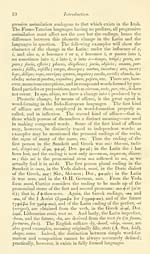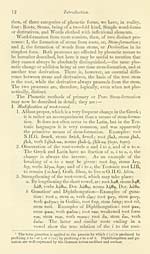Blair Collection > Celtic studies
(41)
Download files
Complete book:
Individual page:
Thumbnail gallery: Grid view | List view

On Roots, Stems, oiul Derlcat'ives. 11
If some of tlic aflixes can thus be derived from significant
words, it is perfectly reasonable that pliilologists should endea-
vour to generalize the fact, and assume as probable that all word-
forming and flexional affixes, which possess the symbolic signi-
fication of formational words, were originally formed by affi.xing
such words to the word to be grammatically modified. In mo-
dern languages where the flexional endings have been worn off",
their functions are again performed by words abeady existing
in the language. Such a view naturally leads to the assumption
that in the gradual development of languages all word-formation
and flexion were synthesis or composition.
The hypothesis that word-formation and flexion were primi-
tively synthesis, and that the phonetic additions by which they are
aftectecl were at first independent words, constitutes the basis of
what is known as the agglutination theory. This theory is now
generally considered to be the correct one. Some philologists
seem disposed, however, to modify it so far as to admit two kinds
of word- forming and inflexional materials: 1, Simple sounds or
syllables, which were never words by themselves, their symbolic
power being derived from that which each individual letter is
considered inherently to possess; 2, independent words worn out
into word-forming and flexional elements.
§. 3. Of Primary Stem-formation.
In the foregoing sections three kinds of forms have been men-
tioned: 1, roots; 2, elementary word-forms; and 3, words clothed
with the inflexional elements, which express their relations to
each other as members of a sentence. But these do not include
every form. The simple word-forms are not as a rule obtained
by the direct addition of a grammatical element, derivational or
inflexional, to the root. Between the root and the grammatically
complete word there lies the icord-stem(FxQiic\\, Radical; German,
Stamm, and corresponding to the Crude-form of some EngHsh
writers), to which, and not to the root itself, the grammatical
elements are added. Stem-formation is, consequently, the first
stage of word-formation, a stem is not a root, nor yet a complete
word. From the root it is logically distinguished in this, that
the unlimited, or, as we might say undulating contents of the
root are fixed or solidified, and rendered fit to serve as a symbol
of the completely determinate conception represented by the
grammatical word. While there are but two classes of Roots,
corporal and formational, there may be many kinds of Stems :
for example, we may have verbal, nominal, pronominal, and
particle Stems — each kind of root branching into many stems,
according to the grammatical changes it may undergo. Instead,
If some of tlic aflixes can thus be derived from significant
words, it is perfectly reasonable that pliilologists should endea-
vour to generalize the fact, and assume as probable that all word-
forming and flexional affixes, which possess the symbolic signi-
fication of formational words, were originally formed by affi.xing
such words to the word to be grammatically modified. In mo-
dern languages where the flexional endings have been worn off",
their functions are again performed by words abeady existing
in the language. Such a view naturally leads to the assumption
that in the gradual development of languages all word-formation
and flexion were synthesis or composition.
The hypothesis that word-formation and flexion were primi-
tively synthesis, and that the phonetic additions by which they are
aftectecl were at first independent words, constitutes the basis of
what is known as the agglutination theory. This theory is now
generally considered to be the correct one. Some philologists
seem disposed, however, to modify it so far as to admit two kinds
of word- forming and inflexional materials: 1, Simple sounds or
syllables, which were never words by themselves, their symbolic
power being derived from that which each individual letter is
considered inherently to possess; 2, independent words worn out
into word-forming and flexional elements.
§. 3. Of Primary Stem-formation.
In the foregoing sections three kinds of forms have been men-
tioned: 1, roots; 2, elementary word-forms; and 3, words clothed
with the inflexional elements, which express their relations to
each other as members of a sentence. But these do not include
every form. The simple word-forms are not as a rule obtained
by the direct addition of a grammatical element, derivational or
inflexional, to the root. Between the root and the grammatically
complete word there lies the icord-stem(FxQiic\\, Radical; German,
Stamm, and corresponding to the Crude-form of some EngHsh
writers), to which, and not to the root itself, the grammatical
elements are added. Stem-formation is, consequently, the first
stage of word-formation, a stem is not a root, nor yet a complete
word. From the root it is logically distinguished in this, that
the unlimited, or, as we might say undulating contents of the
root are fixed or solidified, and rendered fit to serve as a symbol
of the completely determinate conception represented by the
grammatical word. While there are but two classes of Roots,
corporal and formational, there may be many kinds of Stems :
for example, we may have verbal, nominal, pronominal, and
particle Stems — each kind of root branching into many stems,
according to the grammatical changes it may undergo. Instead,
Set display mode to: Large image | Transcription
Images and transcriptions on this page, including medium image downloads, may be used under the Creative Commons Attribution 4.0 International Licence unless otherwise stated. ![]()
| Early Gaelic Book Collections > Blair Collection > Celtic studies > (41) |
|---|
| Permanent URL | https://digital.nls.uk/75771633 |
|---|
| Description | A selection of books from a collection of more than 500 titles, mostly on religious and literary topics. Also includes some material dealing with other Celtic languages and societies. Collection created towards the end of the 19th century by Lady Evelyn Stewart Murray. |
|---|
| Description | Selected items from five 'Special and Named Printed Collections'. Includes books in Gaelic and other Celtic languages, works about the Gaels, their languages, literature, culture and history. |
|---|

